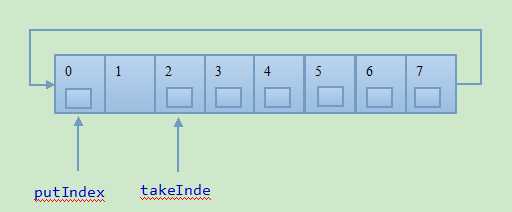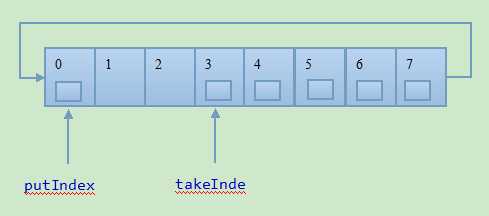标签:
扯淡:
乘着有空,读些juc的源码学习下。后续把juc大致走一边,反正以后肯定要再来。
主题:
java.util.Queue that additionally supports operations that wait for the queue to become non-empty when retrieving an element, and wait for space to become available in the queue when storing an element. | Throws exception | Special value | Blocks | Times out | |
| Insert | add(e) |
offer(e) |
put(e) |
offer(e, time, unit) |
| Remove | remove() |
poll() |
take() |
poll(time, unit) |
| Examine | element() |
peek() |
not applicable | not applicable |
// 队列存放元素的容器 final Object[] items; // 下一次读取或移除的位置 int takeIndex; // 存放下一个放入元素的位置 int putIndex; // 队列里有效元素的数量 int count; // 所有访问的保护锁 final ReentrantLock lock; // 等待获取的条件 private final Condition notEmpty; // 等待放入的条件 private final Condition notFull;
2,整个队列是有一个环绕机制的,比如这时候我一直取数据,那么读取的下标会一直后移,知道数组的末尾。如果这时候制定数组的尾部后一个下标时数组的头位。如此即实现环绕的一个队列。如此实现十分精妙,可说是整个队列实现的基础机制。
如此,这个队列的容量是不可改变的。
// 指针前移 final int inc(int i) { return (++i == items.length) ? 0 : i; } // 指针后移 final int dec(int i) { return ((i == 0) ? items.length : i) - 1; }
3,直接看下核心的put和take方法实现:
put
public void put(E e) throws InterruptedException { checkNotNull(e);//不能放null final ReentrantLock lock = this.lock;//先把锁赋给final修饰的局部变量 // 在JUC的很多类里,都会看到这种写法:把类的属性赋值给方法内的用final修饰一个变量。 // 这是因为类的属性是存放在堆里的,方法内的变量是存放在方法栈上的,访问方法栈比访问堆要快。 // 在这里,this.lock属性要访问两次,通过赋值给方法的局部变量,就节省了一次堆的访问。 // 其他的类属性只访问一次就不需要这样处理了。 lock.lockInterruptibly();//加锁 try { //循环保证避免避免虚假唤醒,虚假唤醒就是此事如果有多个线程都wait,
//而被同时唤醒时都会去执行下面的insert //如果在while循环中,那么唤醒后先判断count大小,来确定是继续wait还是insert。 while (count == items.length) notFull.await();//阻塞线程 insert(e); } finally { lock.unlock();//释放锁 } }
take
public E take() throws InterruptedException { final ReentrantLock lock = this.lock; lock.lockInterruptibly(); try { while (count == 0) notEmpty.await(); return extract(); } finally { lock.unlock(); } }
其中使用到insert和extract方法,当然也可以看到只有持有锁的情况下才会调用这两个方法,如此这个方法的调用不需要关系是否线程安全,调用前保证线程安全:
private void insert(E x) { items[putIndex] = x;// 1,存值,非常简便 putIndex = inc(putIndex);//2,移动下标,使用inc方法 ++count;//3,增加元素总数 notEmpty.signal();//4,通知在非空条件上等待的读线程 }
private E extract() { final Object[] items = this.items;//先将类变量赋给方法变量,前面提过这个用处 E x = this.<E>cast(items[takeIndex]); items[takeIndex] = null; takeIndex = inc(takeIndex); --count; notFull.signal(); return x; }
操作示意图:
1,一个环的数组

2,再放一个元素:

3,取一个元素

当然ArrayBlockingQueue里还有其他方法,这里就不赘述了。有兴趣的同学可以深入继续探索。
总结:
1,一个环的数组设计十分巧妙。
2,将类变量赋给方法变量的编码方式
让我们继续前行
----------------------------------------------------------------------
努力不一定成功,但不努力肯定不会成功。
ArrayBlockingQueue-我们到底能走多远系列(42)
标签:
原文地址:http://www.cnblogs.com/killbug/p/4413017.html